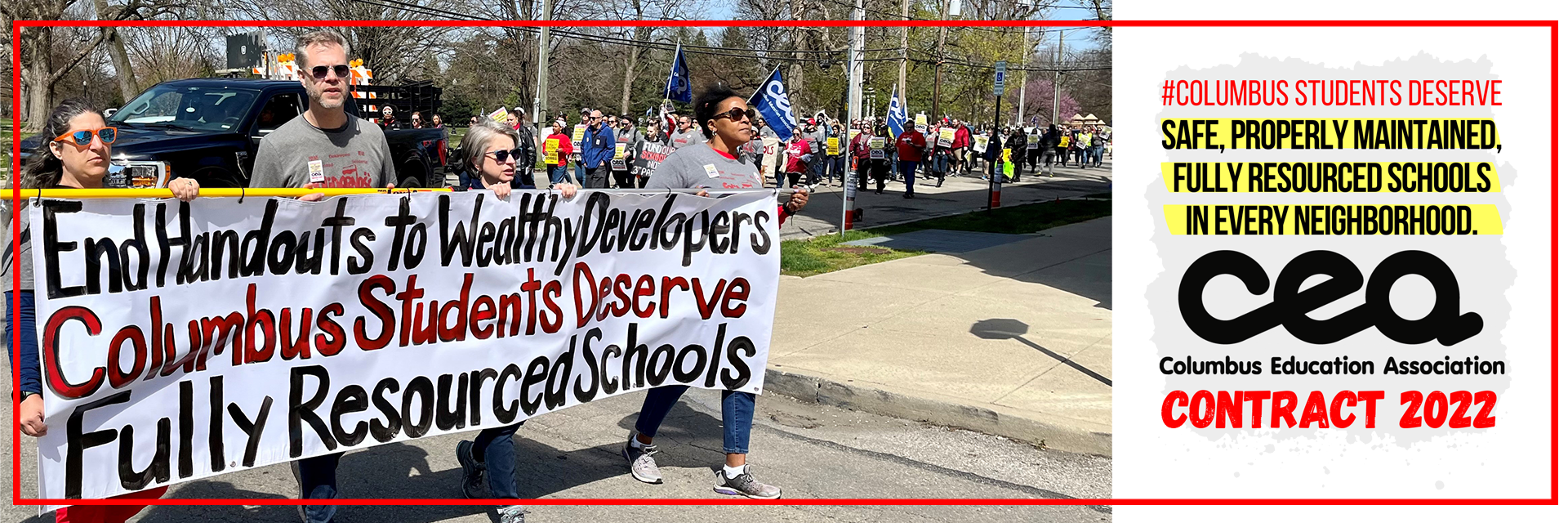by Aaron Williams
After five months of unsuccessful bargaining, the Columbus, Ohio public school teachers and other education workers voted on August 21, 2022 to reject the city’s Board of Education’s second, “last, best and final offer.” The vote was overwhelming—94 percent in favor of a strike. They struck the next day, August 22, upon expiration of their contract. After three days of the strike, they won a decent contract.
 Credit: Columbus Education Association
Credit: Columbus Education Association
This was a landmark strike, not only for Columbus, but also for public schools nationwide. US public school systems are plagued by municipal financial crises and attendant issues of fatalism, teacher attrition, increasing class sizes, cutbacks in art, music and physical education classes and personnel, lack of teaching materials and equipment, outsourcing of jobs to private, for profit, companies, and deterioration of school buildings and facilities that need updating and regular maintenance—including, like in Columbus, air-conditioning and adequate heat in school buildings.
In Columbus, as well as nationwide, financial crises and poor conditions are the new normal in US public school systems.
In addition to these problems for both teachers and students, increasing levels of stress and anxiety about violence in schools, as well as the COVID pandemic since 2020, have put special burdens on teachers. As essential workers, they struggle to continue to provide meaningful education for students, as they had signed up to do when they became teachers.
Fruitless Collective Bargaining
Five months before their contract expired, on March 28, 2022, negotiations with the Columbus Board of Education were begun by the Columbus Education Association (CEA), an affiliate of the National Education Association (NEA), representing over 4,000 Columbus city public school teachers, librarians, counselors and other education workers in the largest public school district in Ohio.
The Board of Education approached negotiations in a traditional fashion, preaching reasonableness and moderation, while making excuses for past broken promises to address long-standing problems. This time the management playbook did not work like it had in the past—ever since the last strike in 1975. This time was going to be different. The education workers had finally had enough and were determined to win changes to benefit both students and teachers that past bargaining had failed to achieve.
From March onward, the teachers and their union representatives and the Board of Education held many bargaining sessions, but by the end of July the Board of Education apparently was finished with bargaining and tried to force a settlement by making its first, “last, best and final offer.” The “offer” was an insult to the workers, who, subsequently filed a Notice of Intent to Strike and Picket with the Ohio State Employment Relations Board. The teachers prepared for a strike.
Shortly thereafter, the Board of Education asked for assistance from a federal mediator and several additional bargaining sessions were held, but with the same, unproductive result. Then, on August 17, the Board of Education made its second, “last, best and final offer.” This, too, was unacceptable to the workers, who, on August 21, voted by 94 to 6 percent to strike the next day.
On Monday, August 22, two days before classes were scheduled to begin, mass picketing began at local school sites by teachers and the general public, who were very supportive of the strike. Picket line slogans and chants like “98 Degrees is a boy band, not a classroom temperature,” and “We want a contract, just and fair, give our classrooms central air” were common.
News coverage of the strike was also very favorable, particularly since the priority issues of the strike were by this time well known. As such, the strike was generally viewed as being for improving students’ education, health and safety.
On August 24, while the strike was in progress and students had been assigned to “remote learning” from home, bargaining resumed, and a tentative “conceptual agreement” was reached. The strike was ended on Thursday, with the teachers and students scheduled to return to their classrooms on Monday, August 29. As part of the tentative agreement, the teachers’ pay and benefits, which were terminated on Monday when the strike began, were to be restored retroactively to the first day of the strike.
Victory for Teachers and Students
Finally, on Sunday, August 28, the workers (CEA members) approved a new contract by a vote of 71 to 29 percent. The 3-year contract contains annual wage increases, class size reductions, staffing and class restorations, as well as health and safety improvements that were the hallmark of this struggle and a daily concern of students, parents, and education workers.
While criticisms could be made of the process, second guessing what the workers accomplished is not the point. Rather, the important thing for now is that workers in motion and in solidarity achieved a positive outcome for themselves and their students.
Hopefully, this will serve as an inspiration to others who are fighting similar battles in the face of school conditions that would never have occurred in a decent society. As part of this process, these workers, despite the reality and constraints of public education under capitalism today, have overcome (some of) their own demoralization and fatalism going forward, and achieved some of their goals. Neither the economic or quality of education improvements would have happened without mass, concerted action. In this respect, the Columbus strike, however imperfect, is an example of a victory, and a positive step forward that hopefully helps galvanize others nationwide who are in the same fight. The struggle continues.

Be the first to comment